You are currently browsing Shannon Wyckoff’s articles.
 Dog Bootie Math is one of our favorite activities during the year. My students love to grab a dog bootie full of math problems and get to work. Over the years I have found that dog booties can hold a variety of activities. Students love trying to figure out what is in their dog bootie. I think it is the mystery of the unknown that keeps my students intrigued during our Dog Bootie Math.
Dog Bootie Math is one of our favorite activities during the year. My students love to grab a dog bootie full of math problems and get to work. Over the years I have found that dog booties can hold a variety of activities. Students love trying to figure out what is in their dog bootie. I think it is the mystery of the unknown that keeps my students intrigued during our Dog Bootie Math.
This is a very easy lesson that is adaptable for any grade and any level of math. I have used Dog Bootie Math for elementary students and high school students. The secret is to mix up which students get which colors each day. One day I may have students working in neon pink booties while the next day they have neon green. So, if you need a quick idea to liven up your classroom….bring in some dog booties!
After spending about 10 days in Alaska, it was time for me to head back to Ohio. However, Winter Storm Saturn decided to hit the lower 48 and cancel all my flights. The “Alberta Clipper” moved quickly across the Midwest, blanketing it in snow. Parts of the Midwest accumulated nearly 15 inches of snow. More than 1,000 flights were cancelled on the first day. Winter Storm Saturn dumped over 20 inches of snow on Virginia. As the storm continued to progress, newscasters began discussing the effect of the snow load on buildings in the lower 48. On March 6th, the roof of the Baby Ballroom at Café La Cave in Des Plaines, Illinois collapsed due to the weight of the snow.
 This made me think of my Dome in Nome Lesson Plan that I use in my classroom. In this lesson students are given the task of calculating snow loads, evaluating architectural designs and planning a new building that can withstand a higher amount of snow load.
This made me think of my Dome in Nome Lesson Plan that I use in my classroom. In this lesson students are given the task of calculating snow loads, evaluating architectural designs and planning a new building that can withstand a higher amount of snow load.  Students will compose a research paper, participate in a structure-building competition, present and display their geo domes and complete the activity by creating a class geo dome. This lessons incorporates applied geometry, physical science, algebra and technology. Each student begins by researching geo domes and snow loads. Geo Domes Facts, Resources for Snow Load and Snow Load Information are provided as resources for students.
Students will compose a research paper, participate in a structure-building competition, present and display their geo domes and complete the activity by creating a class geo dome. This lessons incorporates applied geometry, physical science, algebra and technology. Each student begins by researching geo domes and snow loads. Geo Domes Facts, Resources for Snow Load and Snow Load Information are provided as resources for students.
The students in my classroom love to participate in the structure-building competition. This year my students used marshmallows, toothpicks and straws for the competition. However, there are alternative materials that can be used for the structure-building competition. Geo Domes Alternative Ideas
The class geo dome is created out of bamboo and duct tape. Each group is given one roll of duct tape and enough bamboo to make 10 triangles. The geo dome on the right was created using the smallest bamboo and was able to hold over 140 pounds! After creating the geo dome, students use weights to see how much weight the geo dome can withstand. Our goal for the large geo domes is to be able to hold the entire groups weight! The students are amazed at the strength of the geo dome and the amount of weight it can withstand. Students discuss how roof design and the architectural design of the building determines the amount of snow load a building can withstand. Try this hands-on lesson that is fun and incorporates Math, Science and Technology!
During preparations for the 2013 Iditarod re-start I came across Scott Janssen, the “Mushing Mortician”, being interviewed by the press. He discussed what he likes to take on the trail to eat and how he warms up his food.
If you were on the Iditarod trail, what would you take to eat? Would you eat it cold or stop and warm it up? How do you eat your pizza and macaroni & cheese?
 Introducing a beautiful Alaskan Husky named Angel. The name Angel often confuses people since Angel is a male but the Spanish pronunciation gives him no complex. He belongs to Martin Buser but is making his way to Nome with Matthew Failor.
Introducing a beautiful Alaskan Husky named Angel. The name Angel often confuses people since Angel is a male but the Spanish pronunciation gives him no complex. He belongs to Martin Buser but is making his way to Nome with Matthew Failor.
Angel’s parents are Wolf and Daisy and I was told he gets his size from Daisy. According to Martin, “He was a very hard keeper as a young dog and because of that, became one of my neutered boys.” Angel is able to run in any position. He is very assertive and keeps the other guys in line.
 Martin went on to say, “In the dog barn he defends his private box like a moray eel sticking his head out and snapping at anybody getting close.” I found this so hard to believe when I visited with Angel at the kennel. He seemed very loving and easy going, at least with the humans. Angel is 10 years old and has been to Nome several times before. He has been described as cool as Clint Eastwood and I would have to say I agree! He is definitely one very cool dog!
Martin went on to say, “In the dog barn he defends his private box like a moray eel sticking his head out and snapping at anybody getting close.” I found this so hard to believe when I visited with Angel at the kennel. He seemed very loving and easy going, at least with the humans. Angel is 10 years old and has been to Nome several times before. He has been described as cool as Clint Eastwood and I would have to say I agree! He is definitely one very cool dog!
Those who can, do. Those who can do more, volunteer. This saying sums up the many volunteers of the Iditarod. It is amazing how many people give so much of themselves to help in every aspect of the Iditarod. If I have learned anything from my experience as a 2014 Iditarod Teacher on the Trail™ Finalist, it is that volunteers make a difference.
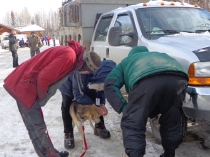 Throughout my entire Iditarod experience, I have been amazed at the wonderful volunteers that are involved in this race. No matter where you are or what you need there is always someone willing to help. When I first arrived at the Millenium and checked into the volunteer desk, the volunteers were very excited to learn where we were from. They answered all of our questions and offered to help us in the future if we needed anything.
Throughout my entire Iditarod experience, I have been amazed at the wonderful volunteers that are involved in this race. No matter where you are or what you need there is always someone willing to help. When I first arrived at the Millenium and checked into the volunteer desk, the volunteers were very excited to learn where we were from. They answered all of our questions and offered to help us in the future if we needed anything.
During the teacher’s conference, we had several volunteers that helped take registrations each day. They would show up early and stay the entire day if they were needed. No matter what we were doing, there was always someone available to help. If we needed a table, duct tape or a stapler, someone ran to find one.
 When you think about all the time and preparation that goes into this race prior to the run down 4th Avenue, it’s astounding. There are volunteers for each and every step of the way. In the summer they have volunteers that help set up tents, sign up mushers and transport supplies. These volunteers are not just here during race time, they are volunteering throughout the entire year.
When you think about all the time and preparation that goes into this race prior to the run down 4th Avenue, it’s astounding. There are volunteers for each and every step of the way. In the summer they have volunteers that help set up tents, sign up mushers and transport supplies. These volunteers are not just here during race time, they are volunteering throughout the entire year.
I asked a few of the volunteers what they liked about helping out, I found I would hear the same thing from each of them. They just love the race and love the people. Most of them said they had become good friends with the volunteers and looked forward to spending time with them again each year.
 I was honored to be able to help in anyway while I was here for the race. I have to say my favorite volunteer time would have to be working in the Race Stats room. It was amazing how much goes on behind the scenes during the race. We were assigned the midnight to 6 a.m. shift. Even though everyone was tired, we had a great time. What a better way to teach our students about helping others than by volunteering.
I was honored to be able to help in anyway while I was here for the race. I have to say my favorite volunteer time would have to be working in the Race Stats room. It was amazing how much goes on behind the scenes during the race. We were assigned the midnight to 6 a.m. shift. Even though everyone was tired, we had a great time. What a better way to teach our students about helping others than by volunteering.
Why do I teach using the Iditarod? It’s all about the future! This photo is one of the reasons I use the Iditarod in my classroom. My students become excited and eager to learn when I use the Iditarod. It allows them to look forward to the future and to be inspired by mushers like Ben Harper. They are able to see others who struggle but overcome what may seem impossible.
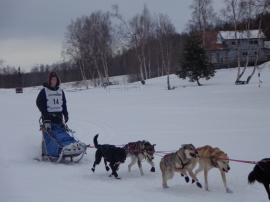 Ben is 16 years old and participates in the Junior Iditarod. He has a great attitude and continues to practice and learn. He wants to someday win the Iditarod. He has a goal and is working towards his goal. My students can relate to Ben, they have goals that seem unreachable but with encouragement they too can achieve what seems impossible. I was fortunate enough to meet Ben this summer when he was asked to talk to our group of teachers. He was a little intimidated, but stood up and answered questions like a pro.
Ben is 16 years old and participates in the Junior Iditarod. He has a great attitude and continues to practice and learn. He wants to someday win the Iditarod. He has a goal and is working towards his goal. My students can relate to Ben, they have goals that seem unreachable but with encouragement they too can achieve what seems impossible. I was fortunate enough to meet Ben this summer when he was asked to talk to our group of teachers. He was a little intimidated, but stood up and answered questions like a pro.
When I think of the future of this race, I think of Ben Harper and his preparations for someday running the Iditarod. He has a dream and is willing to set goals to achieve that dream. My students may never dream of running the Iditarod but their dreams require hard work and planning just the same. Their future can be full of adventure just like Ben’s. My goal as a teacher is to always keep reaching for what may seem to be impossible. You never know what adventures your future may hold!
One of the most exciting assignments that I have had as a finalist was to interview a musher! I knew immediately whom I wanted to interview! Mathew Failor had to be my first choice! I was extremely excited to have the opportunity to ask him some questions that my students and I had discussed prior to my trip to the Iditarod. 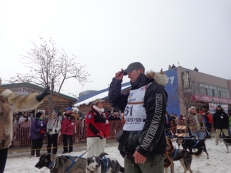
Matt is from Mansfield, Ohio which is about 30 minutes from where I teach at Willard High School. He will celebrate his 31st birthday on March 10th while on the Iditarod trail. Matt graduated from Ohio State University with a degree in Fine Arts Photography. He began racing in 2008 and fell in love with it. Last year he took Martin Buser’s yearling team to Nome and loved the experience. He finished the 2012 Iditarod in 47th place with 14 dogs!
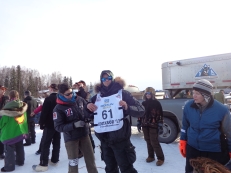 This year he decided to do the Yukon Quest and the Iditarod. During the Yukon Quest Matt had a little mishap with his contacts. He had placed in contacts into a cup before going to bed. The next morning he woke up and was thirsty. He said it took him a little while to figure out where his contacts were. When I asked him what he was going to do to prevent it from happening again he said, “I am leaving them in!”
This year he decided to do the Yukon Quest and the Iditarod. During the Yukon Quest Matt had a little mishap with his contacts. He had placed in contacts into a cup before going to bed. The next morning he woke up and was thirsty. He said it took him a little while to figure out where his contacts were. When I asked him what he was going to do to prevent it from happening again he said, “I am leaving them in!”
 Matt’s Iditarod team consists of: Two-Face, Presto, Mamba, Hillary, Caribou, Angel, Smiley, Goose, Weasel, Happy, Neil Young, Glover, Rock, Bagheera, Vesuvius and Killauea. They are all very lovable dogs and were calm prior to race start. Once they were in their harnesses they were jumping and ready to run!
Matt’s Iditarod team consists of: Two-Face, Presto, Mamba, Hillary, Caribou, Angel, Smiley, Goose, Weasel, Happy, Neil Young, Glover, Rock, Bagheera, Vesuvius and Killauea. They are all very lovable dogs and were calm prior to race start. Once they were in their harnesses they were jumping and ready to run!
When I asked Matt what he liked to eat on the trail his answer was, “homemade stuff.” He said he likes to make most of his meals and have them bagged up. He likes to eat lots of granola bars, spaghetti and moose stew. He said he doesn’t really take sweets and likes to eat pretty healthy.
 For the ceremonial start Matt’s dogs were wearing bow ties thanks to Matt’s sponsor Beau Ties Ltd. of Vermont. I must say they looked quite adorable!
For the ceremonial start Matt’s dogs were wearing bow ties thanks to Matt’s sponsor Beau Ties Ltd. of Vermont. I must say they looked quite adorable!
It was very interesting to watch Matt prepare for the race today. He remained calm and spent a great deal of time just loving on the dogs prior to the race. However, when the 10-minute warning came it was game time! The dogs were jumping and Matt was running in front of the team to the start line. Once they were under the start banner the dogs were slamming in their harnesses and Matt had his game face on. It was great to get a chance to meet Matt and I wish him the best of luck! All the way to Nome, Matthew Failor #61!
If I had to describe today in one sentence I would have to say, today was all about the love of dogs! As I walked around watching the mushers prepare for the ceremonial start I came upon Lance Mackey 4 time Iditarod champion. Lance had brought some young pups to help him travel down 4th Avenue. For the ceremonial start mushers do not have to use the dogs they will use for the actual race. Lance’s pup had never been to the ceremonial start before and was not sure he liked all the attention.
 Lance bent down and spoke to the pup for several minutes. He spent a few minutes talking to the young pup and coaxing it out from under the truck. After placing the harness on the pup, Lance spent some more time loving on the young pup. This was a common theme that I experienced throughout the day.
Lance bent down and spoke to the pup for several minutes. He spent a few minutes talking to the young pup and coaxing it out from under the truck. After placing the harness on the pup, Lance spent some more time loving on the young pup. This was a common theme that I experienced throughout the day.
 Scott Janssen, the Mushing Mortician, walked up and down his entire line of dogs. Each dog not only received a bunch of pats but quite a few hugs and kisses. He spent a great deal of time with each dog prior to the ceremonial start. It is amazing the bond these mushers have with their dogs. They are just like family and they treat them as such.
Scott Janssen, the Mushing Mortician, walked up and down his entire line of dogs. Each dog not only received a bunch of pats but quite a few hugs and kisses. He spent a great deal of time with each dog prior to the ceremonial start. It is amazing the bond these mushers have with their dogs. They are just like family and they treat them as such.
Ugly is Nicolas Petit’s lap dog or I would call him a chair dog. When I walked by Nicolas’s dog truck I noticed Ugly sitting in a chair. Nicolas told me that Ugly would be helping pull the sled for a few miles but then we would go into the bag with the Idita-rider. Ugly does not live up to his name at all. He is actually quite adorable and loves to snuggle. It was truly evident how much Nicolas cares for Ugly.
It was amazing to see how each and every musher put their dog needs above anything else today. This sport truly is all about the dogs. These amazing athletes are Michael Jordan, Dale Earnhardt and Steve Prefontaine all wrapped into one. All in one lovable furry package! This race truly is all about the love of the dogs!
 As the fans poured into the Dena’ina Civic Center in downtown Anchorage, the talk was all about the numbers. Each musher would be called on stage to draw a bib number from a mukluk. A mukluk is a native Alaskan boot made of reindeer or sealskin. It is tradition for the mushers to draw their bib numbers from the mukluk.
As the fans poured into the Dena’ina Civic Center in downtown Anchorage, the talk was all about the numbers. Each musher would be called on stage to draw a bib number from a mukluk. A mukluk is a native Alaskan boot made of reindeer or sealskin. It is tradition for the mushers to draw their bib numbers from the mukluk.
Entering the Civic Center you can feel the excitement in the air. Hobo Jim started us off with some wonderful Iditarod music. While the Iditarod Trail Song played in the background, fans located their tables and got in line for a free poster. There were almost 1,800 people attending the musher banquet this year.
 Students from all over the country participated in a table topper contest for the musher banquet. This year’s table toppers included little red lanterns and dogs’ with the musher’s information on them. I walked around and took a few pictures of some table toppers from Brookesville, Maine. I was lucky to get a few of the mushers to pose for some pictures with them including DeeDee Jonrowe. Click here for more pictures of the musher banquet.
Students from all over the country participated in a table topper contest for the musher banquet. This year’s table toppers included little red lanterns and dogs’ with the musher’s information on them. I walked around and took a few pictures of some table toppers from Brookesville, Maine. I was lucky to get a few of the mushers to pose for some pictures with them including DeeDee Jonrowe. Click here for more pictures of the musher banquet.
 We enjoyed a wonderful meal and then the real fun began! As the mushers are drawing out numbers, fans are busy writing down who drew what and collecting autographs. Each musher is given a few minutes after drawing their bib number to thank their sponsors. It was interesting to sit back and watch the mushers interact with each other. Most of them are best of friends and enjoy the rivalry that the Iditarod creates. Lance Mackey talked about how Jeff King had posted on Facebook that the only way Lance could beat him was if he had a plane. Lance joked and said he had sold three of his four trucks and bought a Leer Jet.
We enjoyed a wonderful meal and then the real fun began! As the mushers are drawing out numbers, fans are busy writing down who drew what and collecting autographs. Each musher is given a few minutes after drawing their bib number to thank their sponsors. It was interesting to sit back and watch the mushers interact with each other. Most of them are best of friends and enjoy the rivalry that the Iditarod creates. Lance Mackey talked about how Jeff King had posted on Facebook that the only way Lance could beat him was if he had a plane. Lance joked and said he had sold three of his four trucks and bought a Leer Jet.
 The mushers continued drawing numbers into the evening. John Baker ended up with lucky number 13 while Lance Mackey drew number 5. Each musher will leave the start line in 2-minute intervals in this new order. The time is eventually made up during their mandatory stop.
The mushers continued drawing numbers into the evening. John Baker ended up with lucky number 13 while Lance Mackey drew number 5. Each musher will leave the start line in 2-minute intervals in this new order. The time is eventually made up during their mandatory stop.
The musher banquet was an amazing experience. In a way it was a lot like a big reunion, friends coming together to celebrate a historical event. This is truly an Alaskan experience that I will never forget. The excitement continues, as race day gets closer. Do you have a lucky number?
Have you ever been so excited to learn, that you showed up early to school or stayed late? When I first began using the Iditarod in my classroom, I noticed a change in my students. They paid more attention and looked forward to coming to school. That is the same reaction we had this morning with an entire room of teachers! We were eager to learn new techniques for using the race in our classrooms.
 The Iditarod allows students to form a connection between learning and an emotional experience. Students become excited when they begin learning about the mushers, the dogs and the adventures of the Iditarod race. As a teacher, I know that when a student is excited they learn more and when they can relate learning to something real…the outcome is amazing!
The Iditarod allows students to form a connection between learning and an emotional experience. Students become excited when they begin learning about the mushers, the dogs and the adventures of the Iditarod race. As a teacher, I know that when a student is excited they learn more and when they can relate learning to something real…the outcome is amazing!
The Iditarod has become an essential teaching tool in my classroom. We begin discussing the race on the first day of school and continue utilizing the race as a resource through the last day of school. The Iditarod can be used for students in every grade level for every subject. I have used the Iditarod to teach everything from applied geometry to basic math facts. Lessons can easily be tied to the Common Core Standards and you can find an assortment of lessons plans by clicking here.
Incorporating 21st Century Skills is easy when you use the race. Students can become connected to their mushers by researching and learning all about their musher’s lives. With the use of technology they cannot only learn about their mushers, but they can learn about the individual athletes that make up each dog team.
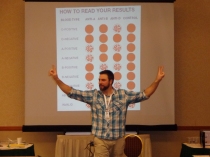 During this mornings presentation Sid Lucas said, “My idea of teaching is doing!” Students who use the Iditarod are actively participating in learning. The Iditarod can challenge bright students to achieve more and help struggling learners find new ways to master complex concepts. The Iditarod is a powerful teaching tool that will provide you with a sled full of ideas!
During this mornings presentation Sid Lucas said, “My idea of teaching is doing!” Students who use the Iditarod are actively participating in learning. The Iditarod can challenge bright students to achieve more and help struggling learners find new ways to master complex concepts. The Iditarod is a powerful teaching tool that will provide you with a sled full of ideas!
